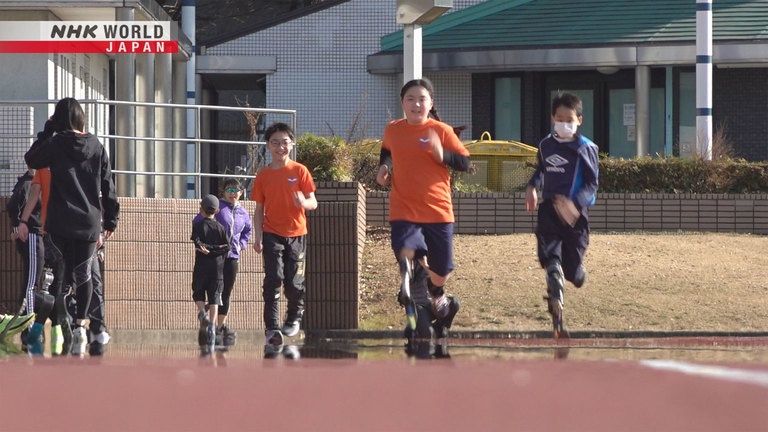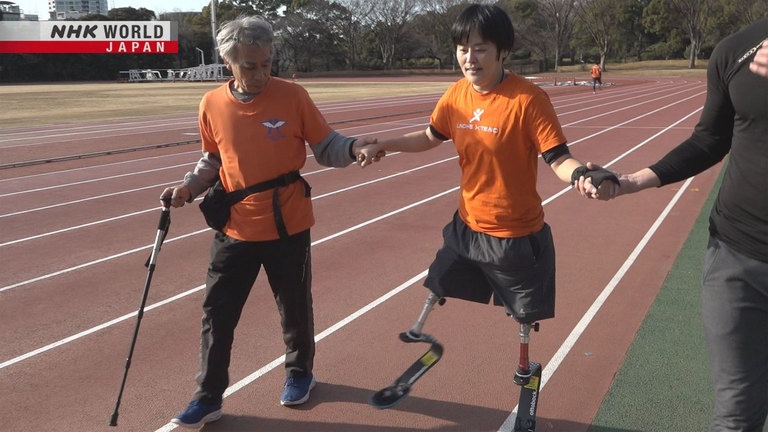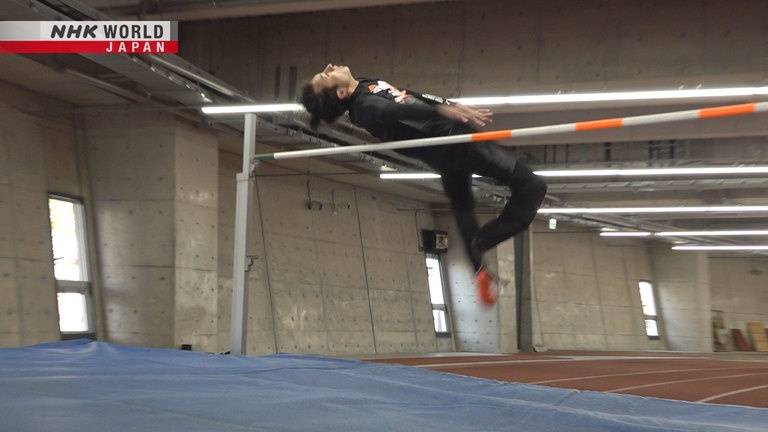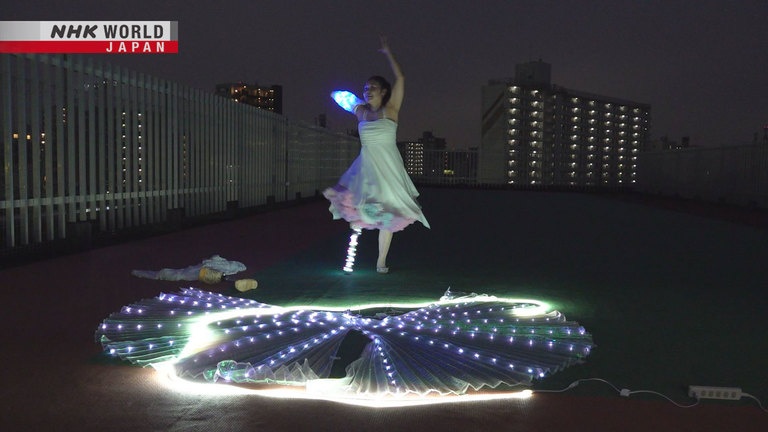Prosthetics Pioneer - Usui Fumio
Usui Fumio is one of the most trusted prosthetists in Japanese para-sports. An early pioneer in the discipline, having developed sporting limbs since the 1980s, he now works arm-in-arm with athletes to craft prosthetics that match their precise needs, underpinning countless successes on both track and field. Away from sports, he also strives to create prosthetics that express users' own identities, appearing on stage in both dance events and fashion shows.




Transcript
FRONTRUNNERS
I'm aiming for a medal in Paris.
He's a legend. I rely on him.
Looking good.
He's the god of prosthetics.
It's about shining brighter, and unlocking endless possibilities.
PROSTHETICS PIONEER
USUI FUMIO
Arakawa Ward, Tokyo is the base of Usui Fumio,
one of Japan's leading prosthetists.
Today, he has a fitting for a new prosthetic leg.
- Here we are. Ready to go.
- Thank you.
- How does it look?
- It looks great.
The recipient is Sri Lankan amputee, Nirukshi Mala Kumari.
Having faithfully used one of Usui's creations for the past 30 years,
she naturally turned to him when it was time for an update.
Let's try walking a little faster.
- Her new leg's all done.
- Great!
Thank you.
It looks great.
I wouldn't be able to walk like this if it wasn't for Usui-san.
I'm so grateful.
More than an artificial leg, it's like a part of me.
It makes me so happy.
Very happy.
- Hi there!
- Long time no see!
Another major client base is para-athletes,
like high jumper Suzuki Toru...
one of only two athletes in the world
to have cleared heights of two meters using a prosthetic leg.
And Usui's technology has been key to a career
that has so far included six Paralympics in a row,
including a fourth-place finish at TOKYO 2020.
They're now working on a new leg
ahead of what Suzuki hopes will be his seventh straight Paralympics in Paris.
The outline is getting clearer.
Has this bit gotten smaller?
Today I wanted to ask about the fit.
Could we make it slightly snugger?
This year I turn 42.
I'm not as explosive as I was,
so I need to transfer my energy more efficiently.
A new socket would give you a tighter fit,
but if we're going to do that, let's take things further.
They begin by taking a cast of Suzuki's stump.
The fit of a socket can have a big impact on an athlete's performance.
The main thing is that he can make me a socket
based on an understanding of how I move.
If it was just about the shape, anyone could do that.
But Usui-san considers how it'll work for running,
or for use in competition.
Every user feels things differently,
and I try to notice things even they don't realize about themselves.
That's the essence of being a professional.
You need to understand the individual,
and adapt the apparatus to them and their own particular needs.
Finding that combination is what this job is all about.
Usui's work in this field goes back four decades,
to a time when no one in Japan was making sports prosthetics.
Five years into his career,
in 1989,
he heard about sporting aids being developed overseas.
I was amazed.
Back then, prosthetics were heavy and cumbersome,
not something you could use to excel in any kind of pursuit.
In those days, the perception was that physical limitations
should be conquered with brainpower,
studying and so on.
But I was fascinated to think what people could achieve
with this new kind of prosthetics.
So, I thought I'd give it a try.
Usui set out with the goal of helping those with disabilities
to experience the joy of sports.
But not everyone approved of his activities.
Some wondered why I was helping these people to run.
They thought they might get injured,
and they couldn't see the value in sports.
It was around that time that he met the then 19-year-old Suzuki Toru.
A promising handball player in his youth,
shortly before entering college,
Suzuki lost his right lower leg in a road accident.
But he was rescued from the depths of despair by Usui's sporting prosthetics.
Every day of my rehabilitation,
I was just eaten up with bitterness and dejection.
But he gave me light at the end of the tunnel,
something to aim for.
The pair set a goal of getting Suzuki onto the world sporting stage.
And together, they went about developing prosthetics
that could make that dream a reality.
But Suzuki's injury presented a major challenge.
The way his leg was amputated had left sensitive areas
around the ends of his tibia and fibula.
It'll hurt if we put pressure here.
And here. Here too.
Even two or three years down the line?
The bone wiggles around in here.
So if that rubs against the inside of the socket,
it'll be very painful.
Usui pledged to come up with a design
that would let Suzuki compete free from pain.
We can't adapt your leg to the prosthetic,
so what we'll do is adapt the prosthetic to your leg.
That's a promise.
And the lessons they learned back then are still coming in handy today.
The starting point for Usui's sockets is a plaster cast of the user's stump.
He makes painstaking adjustments to match the shape as closely as possible.
And to achieve a more comfortable fit,
here he gently layers up the regions where Suzuki's bones jut out.
This bit where the bone protrudes could rub against the socket.
It's actually the top of his fibula.
With all his weight on it, it could press into the socket quite painfully.
So we need to build in a little breathing room below that.
We account for all sorts of movement as we build things up.
The aim is a living, breathing prosthetic that you forget you're wearing.
After all, some level of discomfort or pain is the norm for prosthetics.
They're a foreign object.
I want to set wearers free from that,
with prosthetics they don't even notice they're wearing.
And to aid with development,
Usui imported cutting-edge components from overseas...
- It sags down quite a bit.
- It does, doesn't it?
like this blade made of strong, light carbon fiber.
The combination of this imported blade with a pain-free socket
completed Japan's first ever competition-ready sporting prosthetic.
And only a month later,
Suzuki Toru would wear the end product at the 2000 Sydney Paralympics.
In the end, he finished sixth,
with a jump of 178 centimeters,
the first ever Paralympic appearance for a Japanese athlete using a prosthetic leg.
It was Usui-san who opened up this path for me.
He's been a vital companion on my journey.
A bond that goes beyond even family.
Working together with Suzuki has really given me the chance to see close up
exactly how his progress has helped bring his strong character
and drive to the fore.
And when I saw him standing there out in the field on his blade,
that was a really big moment for me.
That was a moment that showed me the value in what we had achieved together.
That's where it really started for me.
Usui's early work with Suzuki was the springboard
for orders from more and more para-athletes.
And to date, his prosthetics have won Japan a combined total
of five Paralympic and eight World Championship medals...
including steady progress for high jumper Suzuki.
In 2017 he took World Championship bronze
with a jump of two meters one centimeter.
And his next aim is to reach the podium at the 2024 Paralympic games in Paris.
- Good morning.
- Good morning.
Even on days off, Usui heads out with prosthetics in tow.
It's like they're my hobby.
No matter what I do,
prosthetic legs are at the heart of it all.
He arrives at a running track near Tokyo Bay.
Startline Tokyo is a monthly track and field club hosted by Usui
to give even non-athletes the chance to enjoy para-sports.
Let's spread out into a long oval shape.
Since launching the club near the start of his prosthetics journey 32 years ago,
Usui has never skipped a single month.
Today's group includes around 30 participants aged from six to 70.
Most people with prosthetics think they'll never be able to run again.
But if they can, it brings positivity and resilience,
a can-do spirit for school and for work.
It helps them take everyday life in their stride
like a kind of magic.
Today's participants include first-timer Sakai Mariko,
invited personally by Usui.
Three years ago, a serious infection forced the amputation
of both her legs above the knee.
Did they fix the angles?
Not yet. My stance is still quite wide.
For sporting use, prosthetics fitted above the knee
require lots of fine adjustments.
How's this? Try walking a little.
Looks pretty good.
Usui monitors closely as Sakai starts off with some walking exercises.
It's tough.
OK, OK.
Alright. Good.
Your regular walking has gotten a lot smoother.
OK. That's it.
Sakai has been working with Usui for the past two years of her rehabilitation.
Immediately post-amputation,
one doctor told her that even with prosthetics,
she may never walk again.
I didn't know what to do.
Thinking about it just made me more depressed.
I wished it was all just a bad dream.
Determined to walk again,
Sakai turned to the rehab center where Usui works.
And thus began her own journey with prosthetics.
From the start, Usui insisted that beyond walking,
she may even be able to run again.
I was stunned. I'd only just started to walk again,
so I thought running would be impossible.
"Think how easy walking will be once you can run," he told me,
which gave me something to aim for.
The pair treated running as a goal that would make everyday life feel easier.
And to strengthen Sakai's remaining thigh muscles,
they tried walking on short prosthetics,
including repeated practice going up and down slopes.
Throughout the process, Usui was on hand to make adjustments
and correct any issues with Sakai's prosthetics.
He's been watching every step of the way,
looking after me every week,
always there to ease my pain
like a real-life guardian angel.
Making someone a prosthetic isn't the endpoint.
It's just the start of the process.
You refine them together,
and the user evolves too.
Let's keep it up.
Thank you. I'll try my best.
And now, having built up her muscles,
the goal for next month is to try running.
After meeting Usui two years ago, she ran on blades for the first time.
And her whole world transformed.
Another Usui initiative is this fashion show entitled "Amputee Venus."
The models are all female prosthetic users.
This double amputee is an athlete.
To symbolize her gold medal hopes, these legs use Kanazawa gold dust.
The theme of this show is dreams for the future
that the models have been unable to fulfill,
but which may be possible through prosthetics.
One participant in Amputee Venus has been dancer Matsuda Yoshie.
Each week, she hones her craft at her local community center.
A former beautician, in 2015,
Matsuda lost her right arm and leg in a traffic accident.
And for some time afterward, she shied away from social contact.
It felt disrespectful to others to let them see me without an arm.
So I'd hide it with long sleeves.
And I'd do my best to pretend my false leg was a real one.
I just couldn't stand it.
Good evening.
After learning about Amputee Venus eight years ago,
she reached out to Usui
who began building and refining prosthetics suitable for dance.
- Can I open it?
- Go ahead.
Usui proposes new designs and adjustments
based on previews of Matsuda's dance routines.
And to help her overcome her self-consciousness,
he created light-up prosthetics
that showcase her disability as a mark of individuality.
I think it's very valuable to take people
who have gotten past grief at their disability,
and showcase them happily dancing on stage.
I'm finally able to present the new me to the world,
embrace dancing on stage in front of people.
It's Usui-san that gave me the courage to do that.
It looks lovely against the night sky.
Indescribable. Like a new world.
Wonderful.
February 2023,
and it's time for this month's track and field club.
As decided last month, Sakai Mariko is ready to try running.
Once fitted with athletic blades, it's time for some practice.
Shall we give it a try?
She gets a primer from Yamane Satsuki,
a fellow double amputee who's been joining these sessions for the past year.
That's it. Up and down.
Another ten meters. You can do it.
OK, that'll do.
Today's 50-meter trial run is the longest distance
Sakai has attempted on blades.
And during a well-earned break,
Yamane offers more advice on how to run.
You need to use your whole body.
Harnessing one's entire body weight
gives the blades more energy to propel the wearer forwards.
Until now, Sakai's practice has focused on the use of her lower body strength.
Next, it's time to try incorporating her upper body, too.
- That's it.
- Feel your weight on the blades?
Yes, thanks to these three.
And thanks to this advice and support,
Sakai is getting a feel for how to run on these blades.
It's a whole different way of using my body,
but I think I've gotten a feel for
how to transfer my bodyweight effectively to the blades,
which is a big step.
I hope I'll be able to run.
She's taking on a really difficult challenge.
But I really hope we can help her to run by herself.
And... Start!
And to date, Usui's track and field club has helped
some 250 participants to rediscover the joy of running.
I thought I'd never be able to run quickly again.
But now I feel ready to take on all sorts of new challenges.
The more I practice, the faster I get,
so I feel like I want to aim for the Paralympics.
Back at Usui's workshop,
a month after the order for a new socket for high jumper Suzuki Toru.
The initial prototype is ready,
with a better fit to help Suzuki aim for a medal in Paris.
And as part of the design, Usui is trying out a new component.
Here's how you put it on.
Like so.
And then under here, that creates a vacuum
which helps generate a more secure fit.
But of course, the final decision as to whether or not to use the new socket
in competition is up to the athlete himself.
How do I put it on? Just pull it over.
Like so?
Then in here, like this?
Oh wow. Like a suction cup!
Yup, suction. For real.
Wow. Wow!
It fits great.
Like it's hugging on, right?
Amazing. It's a very snug fit.
Feels like it would be great for competition.
Wow, this is amazing.
Obviously, it's hard for me to know how it feels.
What can I say? It reacts well as I lift my leg.
Like it's coming with you?
My old legs always lagged behind a little.
This is a big improvement.
Great.
It really is. Even better than I could have imagined.
Next stop, Paris!
I think we can make it, can't we?
Hopefully he can stretch his personal best.
I'm sure he can.
And as Usui Fumio continues his quest to expand the potential of prosthetics...
what is it that motivates him as a frontrunner in his field?
I get to work with people who are active in all sorts of areas,
from dance to people who travel the world for work.
And for me to be a part of helping those people grow,
being able to witness that,
well, I think that's just the best feeling.
Every person I've worked with is a treasured relationship.
And for them to be able to live their lives with fresh confidence,
well, the more of them I see,
the more I'm glad I chose this path.
That's precious to me.